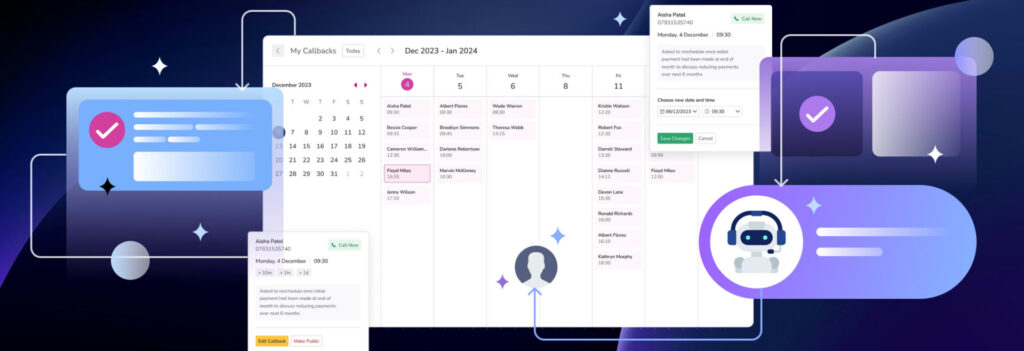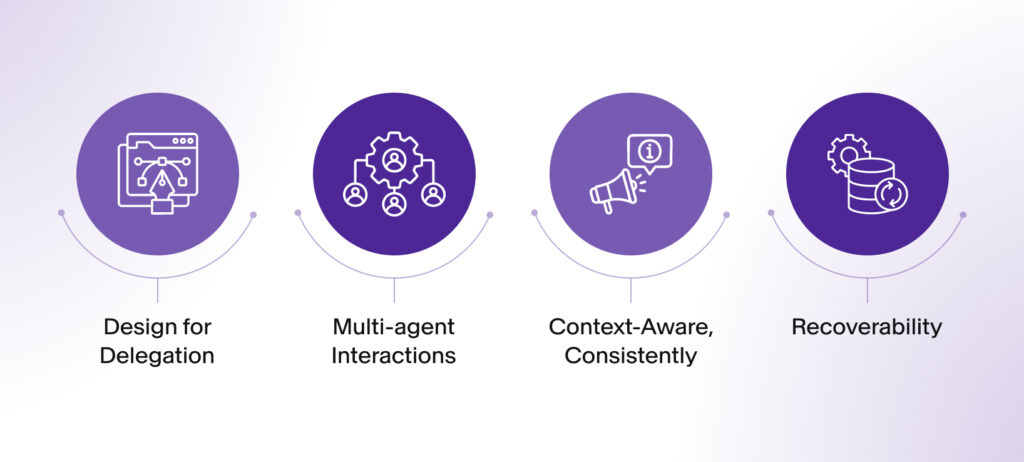Digital experiences have evolved from simple interfaces to AI-powered systems that anticipate and adapt. But the next paradigm shift is already here: Agent Experiences, where autonomous AI agents act on behalf of users, completing tasks, negotiating outcomes, and coordinating across systems in real time.
This represents a fundamental shift in how organizations deliver value. The question isn’t whether this will impact your business, it’s whether you’ll lead the transition or scramble to catch up.
Stuti Mazumdar - July 2025

Understanding Agent Experiences
Agent Experiences (AX) are digital ecosystems designed for AI agents to operate on behalf of users, fulfilling goals, making decisions, and interacting with other agents or systems autonomously.
Unlike traditional AI assistants that respond to commands, these agents function as autonomous task managers. They process multiple instructions simultaneously, decompose complex goals into executable workflows, navigate across applications, and continuously learn and optimize performance.
Here’s the distinction: You don’t tell them how to do something; you tell them what you need done.
Traditional approach: “Open my calendar. Find available slots. Book an appointment with Dr. Kumar for next Tuesday.”
Agent approach: “Schedule a dentist visit this week.”
The agent handles the rest, checking availability, coordinating schedules, sending confirmations. A well-designed AX ensures your agent can navigate systems seamlessly to execute these tasks without friction.
The business implication: Your customers will increasingly expect outcomes, not processes. They won’t want to navigate your systems; they’ll expect their agents to do it for them.
Why Agent Experiences Are a Strategic Priority Now?
Three market forces are converging to make AX a strategic imperative:
1. AI Capabilities Have Reached Commercial Maturity
Advanced language models now handle complex reasoning, multi-modal inputs, and contextual decision-making at scale. The technology is production-ready, and early adopters are already capturing competitive advantages. Your competitors are likely already piloting agent-driven experiences.
2. Infrastructure Commoditization Enables Rapid Deployment
APIs, cloud services, and integration platforms have made cross-system agent operation feasible and cost-effective. What required 18-month development cycles now takes quarters, reducing your window to respond strategically.
3. Customer Expectations Are Shifting Irreversibly
Users experiencing friction-free agent interactions in one domain will demand them everywhere. Customer tolerance for manual processes is declining. Organizations that don’t adapt will see measurable impacts on satisfaction scores, retention rates, and market share.
Four Non-Negotiables for Agent-Ready Infrastructure

Building effective Agent Experiences requires rethinking fundamental assumptions about how your organization delivers value:
1. Optimize for Delegation, Not Navigation
Traditional UX prioritizes making systems usable. Agent Experience design prioritizes making systems delegable.
What this means operationally: APIs must provide clear pathways for common workflows. Systems must communicate intended actions before execution. Transparency mechanisms must build trust without requiring human verification for every step.
2. Architect for Multi-Agent Orchestration
Multiple agents will operate simultaneously, customer agents, internal automation agents, partner system agents. Your infrastructure must support coordinated multi-agent workflows.
What this means operationally: Design for information exchange between agents, not just between users and your system. Establish clear protocols for agent authentication and authorization. Build conflict resolution mechanisms for competing agent requests.
3. Embed Context-Awareness as Infrastructure
Agents require rich contextual data to make intelligent decisions. Systems must provide appropriate context without compromising security or privacy.
What this means operationally: Implement granular permission models that agents can navigate. Provide real-time system state information to authorized agents. Design for context portability across organizational boundaries.
4. Build Recoverability into Every Workflow
When agents make mistakes, and they will, organizations need mechanisms to review, reverse, and learn from those decisions without catastrophic consequences.
What this means operationally: Maintain comprehensive audit trails of agent decisions. Implement rollback capabilities for reversible actions. Design escalation pathways for human intervention.
What This Means for Your Bottom Line?
1. Market Position and Competitive Moats
As agents become the primary interface between customers and services, AX quality can become a defensible moat. Early investment in agent-ready infrastructure can establish category leadership.
2. Technical Debt and Infrastructure Investment
Legacy human-centric systems will likely require significant refactoring. The technical debt of human-only interfaces can compound quickly; strategic investments now may prevent costly emergency migrations later.
3. Brand Differentiation and Customer Expectations
Seamless agent interactions can differentiate brands in crowded markets. Agent-ready capabilities should become a core value proposition, not merely a feature addition.
4. Workforce Evolution and Skill Development
As agents handle routine tasks, human roles will shift toward oversight and strategic decision-making. Organizations should prepare teams now for agent-augmented work environments through targeted upskilling.
Ethics as Competitive Advantage, Not Compliance
As agents make autonomous decisions on behalf of users, organizations face heightened ethical and regulatory obligations:
Privacy and Data Governance: Agents require access to sensitive information. Robust data governance frameworks aren’t optional, they’re foundational to maintaining user trust and regulatory compliance.
Algorithmic Accountability: When agents make decisions with material impact, organizations must demonstrate how those decisions were reached. Explainability and auditability are business requirements, not technical features.
User Sovereignty: Users must retain meaningful control over agent behaviour. Designing for user-defined boundaries and override mechanisms protects both customers and organizations from unintended consequences.
Organizations that treat ethical design as a compliance burden rather than a strategic asset will face reputational and regulatory risks that materially impact business outcomes.
The Agent-Ready Future Starts with Design
Agent Experiences aren’t a future trend to monitor, they’re a present reality reshaping competitive dynamics across industries.
Organizations face a clear choice: invest strategically in agent-ready infrastructure now or accept the compounding costs of technical debt and competitive disadvantage later.
The winners won’t be those who simply implement agent capabilities. They’ll be organizations that design Agent Experiences with the same rigor, ethics, and strategic foresight they bring to their core business operations.



